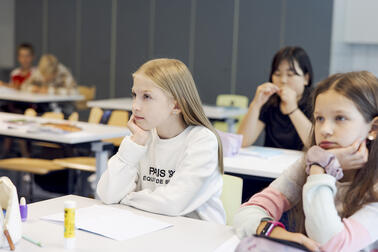
Anna Takkunen works as a psychologist at Alppila Upper Secondary School and Heidi Kuvaja at Stadin AO's Prinsessantie unit. They and other professionals share a goal to combat the loneliness, insecurity, fatigue and stress experienced by young people. The means for this are often similar in general upper secondary schools and vocational collages.
“We strive to provide students with many opportunities to get to know each other. There are tutor activities, an entrance party, recess activities organised by a youth worker and leisure activities organised by liikuntacoach instructors that aim at promoting overall health and well-being through movement and exercise,” says Takkunen.
Stadin AO also pays a lot of attention to creating a sense of community. They invest in the well-being of young and adult students alike in many ways.
“We get together at the school to plan new opportunities for team building and community building. We have several such events,” says Kuvaja.

Student welfare is there for young people
Each educational institution has a group of professionals responsible for improving well-being in the school. The group includes student welfare professionals, heads of training, guidance counsellors and the principal. The student welfare professionals consist of psychologists, counsellors, school nurses, registered nurses and a doctor.
“We consider and plan how we can prevent loneliness or deal with substance abuse themes, for example,” says Kuvaja.
The themes of well-being have been added to the content of the students’ studies. Workshops have been held about sleep and self-soothing, among other topics.
Takkunen believes that the creation of a sense of community is worth investing in, as a community perceived as meaningful also affects learning. Conversely, if a student constantly feels lonely and has no friends, going to school may start feeling difficult and the student has less motivation to study.
The feeling of security increases with small actions
Both general upper secondary schools and vocational schools organise events and workshops in which staff and students together consider how to increase safety. What are the rules of a safe space and how can bullying be prevented?
In Alppila Upper Secondary School, the rules of a safe community are discussed during functional lessons. The Prinsessantie unit also goes over the rules of a safe community together. Together with the staff of the educational institution, students consider how each person should act in order for everyone to feel safe.
Small group meetings also discuss increasing the sense of community and reducing loneliness.

Such a discussion is also an opportune moment to remind students to respect others and behave in a way that is considerate of others.
“Anyone can influence the culture and community around them by taking others into account – by greeting them, for example,” Kuvaja says.
A sense of security is also born when students feel that there are adults in the educational institution who can be easily reached.
Teachers can also direct students to a psychologist
The reasons a student may seek the help of a psychologist are very varied. Some young people are stressed and some want to talk about relationship issues. Crises in the students’ lives are also a reason for some of the visits.
Depression and anxiety have become more common among young people. This and other challenges to mental well-being are reflected in the work of psychologists.
“The student's mood may be low, or they may be tired or just not able to cope. Sometimes the student has lost their motivation to study. They may also have anxiety or attention problems,” Kuvaja says.
A young person can also be directed to the psychologist by a teacher. If a student's studies do not progress, it is the teacher's responsibility to direct the student to a counsellor or psychologist.

Anxiety affected by the coronavirus
“Young people's problems are often blamed on the coronavirus pandemic, although in reality many unpleasant phenomena already existed before that,” Takkunen says. However, isolation from peers has left its mark in young people, and this can take the form of social anxiety, for example. Takkunen hopes that political decision-makers will keep the well-being of young people in mind when allocating resources or deciding on group sizes, for example.
The educational institution is able to do its part in supporting young people if their studies become too stressful.
“Each student and situation is unique. Together, we think of ways to support the studies and well-being of each individual,” says Takkunen.
She makes visits to an educational guidance course to tell students about coping and well-being with the counsellor and the public health nurse.
Considerable attention paid to absences
Schools and educational institutions want to prevent young people from falling by the wayside. The new government programme also states that “the Government will take determined action to reduce discontinuation of studies in upper secondary education”.
The psychologists discuss how dropping out is caused by many things, and the problem is complex and societal. Unwillingness to study does not usually begin at the upper secondary level – instead, the student has often already had difficulties in comprehensive school.
“It’s good that the age limit for compulsory education was raised. In addition to the fact that the education is free, another positive aspect is that we now have the opportunity to get assistance from child welfare professionals,” Heidi Kuvaja says.
Sometimes the accumulation of absences is caused by old experiences with bullying, which the student can now work on in meetings with a psychologist.
When a young person is about to drop out of their place of study, their problems are rarely simple. Major structural problems cannot be solved at the individual level, but the educational institution can do its part. Takkunen and Kuvaja both emphasise encountering the student as an individual.


A group of professionals can be assembled for the student, and together they will search for the best ways to help and support the student.
The psychologists stress that more resources should be made available for the treatment of mental health problems: if a student needs treatment that is not available in educational institutions, they may have to wait for the treatment for a good while.
Organising thoughts and gaining new insights
Kuvaja and Takkunen say that helping students find a way forward is at the core of their work.
“The solution to the student’s problem is rarely ‘do this and everything will be okay,’ but things may still start falling into place in the student's mind,” Takkunen says.
The young person may gain more self-understanding or a new insight that takes them forward. It is also significant that the young person feels seen and heard after talking to a psychologist.
“It’s important to give students the opportunity to safely pause and contemplate their feelings and experiences,” says Takkunen.
Text: Kirsi Riipinen
This article is part of a series that introduces Helsinki's actions to build a good future together, for each of us.
#education2030 #helsinkilearns #helsinkieducationfuturecompetences


